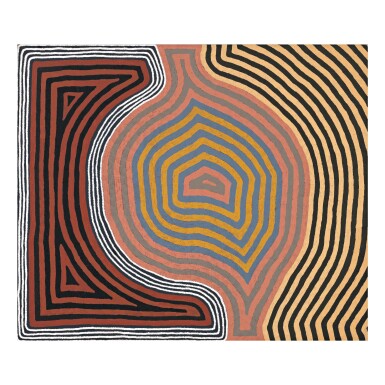Aboriginal Art
Aboriginal Art

RONNIE TJAMPITJINPA | TINGARI CEREMONIES AT THE SITE OF PINTJUN
Auction Closed
December 13, 10:40 PM GMT
Estimate
120,000 - 180,000 USD
Lot Details
Description
Property from the Collection of Gabrielle Pizzi
RONNIE TJAMPITJINPA
BORN CIRCA 1943
TINGARI CEREMONIES AT THE SITE OF PINTJUN
Synthetic polymer paint on linen
Bears artist’s name and Papunya Tula Artists
catalogue no. RT890931 on the reverse
60 in by 71 in (152 cm by 180 cm)
Painted at Kintore for Papunya Tula Artists Alice Springs, 1989
The Gabrielle Pizzi Collection
Thence by descent
Achille Bonito Olivia, Aborigena, Arte Australiana Contemporanea, Torino, Palazzo Bricherasio, Electa, Milano 2001, p.42, pl.4.
Achille Bonito Olivia, Desert Art, Electa, Milano, 2002, p.42, pl.4.
Achille Bonito Olivia and Gabrielle Pizzi, Mythology and Reality, Contemporary Aboriginal Desert Art from the Gabrielle Pizzi Collection, The Jerusalem Centre for the Performing Arts, Jerusalem, Israel, p.28, illus.
Kasper Konig, Emily Joyce Evans, Falk Wolf (ed.s), Remembering forward: Australian Aboriginal painting since 1960, Paul Holberton Publishing, Cologne: Museum Ludwig, 2010, p. 71, pl. 27, detail (cover), illus.
Palazzo Bricherasio, Turin, Aborigena: Arte australiana contemporanea, 29 June-26 August 2001.
Aboriginal Art Museum, Utrecht, The Netherlands, Desert Art, Gabrielle Pizzi Collection, 23 February - 23 June 2002.
The Jerusalem Centre for the Performing Arts, Jerusalem, Israel, Mythology and Reality, Contemporary Aboriginal Desert Art from the Gabrielle Pizzi Collection, 21 October – 19 December 2003.
Museum Ludwig, Cologne, Remembering forward: Australian Aboriginal painting since 1960, 18 November 2010 – 19 March 2011.
Ronnie Tjampitjinpa, Art Gallery of New South Wales, 4 April - 1 November 2015.
RONNIE TJAMPITJINPA
A full understanding of Ronnie Tjampitjinpa's work begins at Papunya in the early seventies with the momentous leap that occurred when aboriginal artists made their first paintings in non traditional materials for purposes other than the ceremonial.
This transformation allowed a freedom and gave new purpose to their imagery and began the development of contemporary aboriginal art in the desert.
Ronnie Tjampitjinpa has always made bold and uncompromising paintings. The Pintupi iconography that formed his vocabulary is similarly potent. However, it is his ability to use the medium of acrylic paint on rectangles of linen that has allowed him to make his statements, about his world today, with a new voice.
Technically Ronnie has taken a relatively limited number of iconic devices and used their various configurations to structure his work. The circle and rectangle in particular, linked with parallel lines, or simply placed within the picture plane give his compositions their skeleton. It is the way in which he is able to use only a select number of elements that gives his work a minimalist edge.
Add to this structure repetitive bands echoing the basic forms and his surfaces develop an intensity which is further enhanced by a sensitive, though somewhat unexpected, palette. Working mainly with the 'traditional' colours of black, white, red ochre and yellow ochre Ronnie mixes delicate hues, rarely using colour straight from the pot. His combination of colours and use of contrasting stronger tones and black further strengthen the impact of his image.
The ubiquitous dot of western desert art is present in Ronnie's work too. There were times when it was presented as an individual unit, side by side with other dots forming linear pattern in his work. But this has given over to a technique where each dot overlaps the next forming bands of pulsing energy. Coupled with his tendency to run two or three lines of the same colour together the effect is often more of a pulsing band as the thick and thin of the paint and the tiny spaces between lines all add their effects. Recently their have also been works where he has abandoned dots altogether and simply painted lines. This has led to different distribution of the paint within the linear bands and new effect, especially when combined with 'dot' techniques.
To view Tjampitjinpa's work in terms of its component structural parts is not enough. His paintings are imbued with a strength and determination that underlies all the formal considerations. These are not anthropomorphic depictions of a Pintubi tradition, they are Ronnie Tjampitjinpa's paintings of today. When we think of Ronnie Tjampitjinpa we should not evoke the romantic notion of the tribal aboriginal living in the remote deserts of central Australia untouched by the outside world.
Think more of a man roaring across thousands of miles of country in his four wheel drive with his spears strapped to the roof rack and paintings in the back.
Ronnie Tjampitjinpa is undoubtedly one of Australia's foremost abstract painters. That his unique work a has emerged from some of Australia's remotest parts, without any art school training or exposure or education in the western tradition of contemporary art is all the more amazing.
Christopher Hodges
